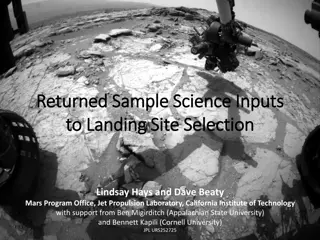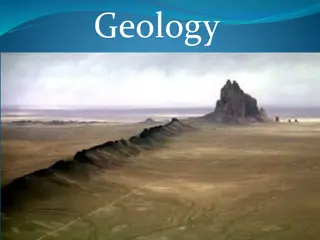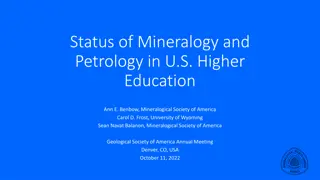
Understanding Earth's Interior and Petrology
Explore the principal subdivisions of the Earth's interior, from the crust to the core, based on seismic wave velocities. Learn about the composition, structure, and characteristics of each layer, and delve into the fascinating field of petrology, which studies rocks and minerals in the Earth's lithosphere.
Download Presentation

Please find below an Image/Link to download the presentation.
The content on the website is provided AS IS for your information and personal use only. It may not be sold, licensed, or shared on other websites without obtaining consent from the author. If you encounter any issues during the download, it is possible that the publisher has removed the file from their server.
You are allowed to download the files provided on this website for personal or commercial use, subject to the condition that they are used lawfully. All files are the property of their respective owners.
The content on the website is provided AS IS for your information and personal use only. It may not be sold, licensed, or shared on other websites without obtaining consent from the author.
E N D
Presentation Transcript
Petrology (1)
THE PRINCIPAL SUBDIVISIONS OF THE EARTH 'S INTERIOR The Principal Subdivisions of the Earth's Interior are based on the distribution of seismic wave velocities in depth. The crust is defined as the region extending from the surface to the Moho discontinuity (major first-order discontinuity), which lies at a depth of 30-50 km beneath most continents (continental crust) and about 10-12 km beneath most oceans (oceanic crust). Continental crust is mostly granite while oceanic crust is basalt, both are igneous rocks. The Moho discontinuity is the lower boundary separates the crust from the upper mantle. The upper mantle is located under the crust and extends to a depth of about 410 km. This region is characterized by regional differences in the distribution of the velocities, where it was discovered from the observation of the spread of the low velocity (low velocity zone "LVZ"), especially for secondary wave velocities (Vs). The upper Mantle composition of ultramafic rock called peridotite.
Transition zone is part of the Earth's mantle, and is located between the lower mantle and the upper mantle, between a depth of 410 and 660 km and is characterized by high-velocity gradients. The lower mantle extending from 660 to 2900 km, is characterized by moderate and relatively uniform increase of seismic velocities with depth. The core is found about 2,900 km below Earth s surface. This is marked discontinuity (Gotenberge discontinuity). The earth's core is divided into two regions: the outer core (2900-5155 km) is characterized by slowdown of primary seismic waves (Vp) and stop secondary seismic waves (Vs), indicating that the outer core is in the liquid state. The inner core (5155-6371 km) passes the secondary and primary seismic waves, indicating that the inner core is a solid. The outer core composed of liquid iron and nickel with sulfur, while the inner core is composed of solid iron and nickel under very high pressure. by major first-order
Earth has a rigid outer layer, known as the lithosphere, which is typically about 100 km thick and overlies a plastic (partially molten) layer called the asthenosphere. As a result, seismic waves slow as they enter the asthenosphere.
PETROLOGY It is the branch of geology that studies rocks in the Earth in general, and particularly the rocks that constitute the Lithosphere or more strictly the Earth's crust. The study includes the rock cycle and rock types, rock classification, their mineralogy, chemistry, description, occurrences, environments of deposition or formation, as well as their genesis (petrogenesis), economic value and uses. Petrology is a Greek term composes of two words: the first petros means the rock, and the second the logos means science. Rock : It is a natural solid substance composed of aggregate of well-cohesive minerals either as grains or crystals; i.e. consolidated substance that is not friable .The rock could be either Monomineralic or Polymineralic: (1) Monomineralic rock: which is composed of one mineral (e.g. dunite "rock" (of olivine mineral); gypsum ''rock'' (of gypsum mineral), quartzite "rock" (of quartz mineral). (2) Polymineralic rock: which is composed of two minerals or more (e.g. peridotite "rock" (of olivine and pyroxene minerals); arkose "rock" (of quartz, feldspars, and other minerals); schist "rock" (of quartz, mica, and other minerals).
TYPES OF ROCKS There are three types of rocks are recognized in the nature, they are: (1) Igneous Rocks: are formed by cooling and crystallization of a molten material (magma) inside, or at the surface of the Earth. Igneous rocks are called hard rocks, and characterized by their rigidity and containing no fossils. (2) Sedimentary Rocks: are formed from sediments derived from pre-existing rocks by precipitation of dissolved ions in water or by accumulation organic materials. Sedimentary rocks are called soft rocks, and characterized by bedding or stratification, and fossiliferous (i.e. containing fossils). (3) Metamorphic Rocks: are formed from the change of pre-existing rocks (known as parent rocks or protolith) into new rocks by the effect of pressure, heat, and hydrothermal solutions. Metamorphism occurs in a solid state without melting of the parent rocks, otherwise the melt will crystallize giving igneous rocks. This process is known as recrystallization. Metamorphic rocks are called also hard rocks like the igneous rocks, and characterized by foliation (small-scale layering). Like igneous rocks, they contain no fossils. of particles, or
ROCK CYCLE The rock cycle is an important concept in geology which illustrates the relationships between these three types of rock, and magma. When a rock crystallizes from melt (magma and/or lava), it is an igneous rock. This rock can be weathered and eroded, and then redeposited and lithified into a sedimentary rock, or be turned into a metamorphic rock due to heat and pressure that change the mineral content of the rock which gives it a characteristic fabric.
The sedimentary rock can then be subsequently turned into a metamorphic rock due to heat and pressure and is then weathered, eroded, deposited, and lithified, ultimately becoming a sedimentary rock. Sedimentary rock may also be re-eroded and redeposited, and metamorphic metamorphism. All three types of rocks may be re-melted; when this happens, a new magma is formed, from which an igneous rock may once again crystallize. rock may also undergo additional








